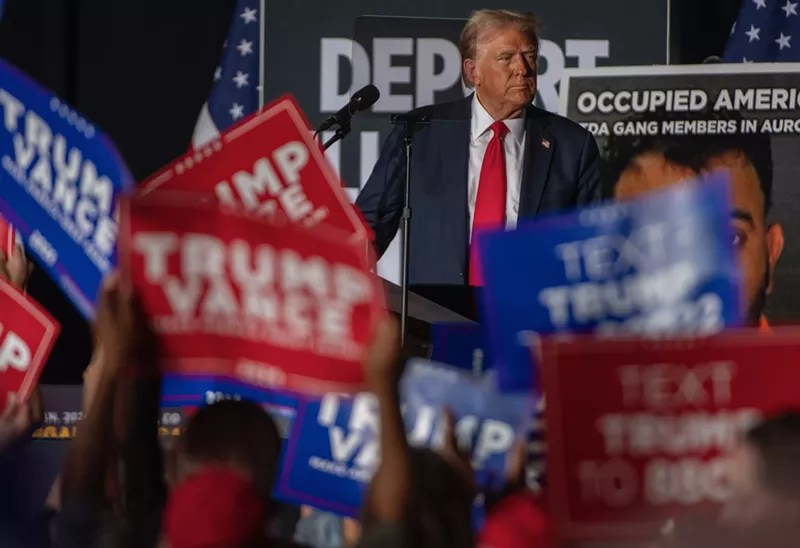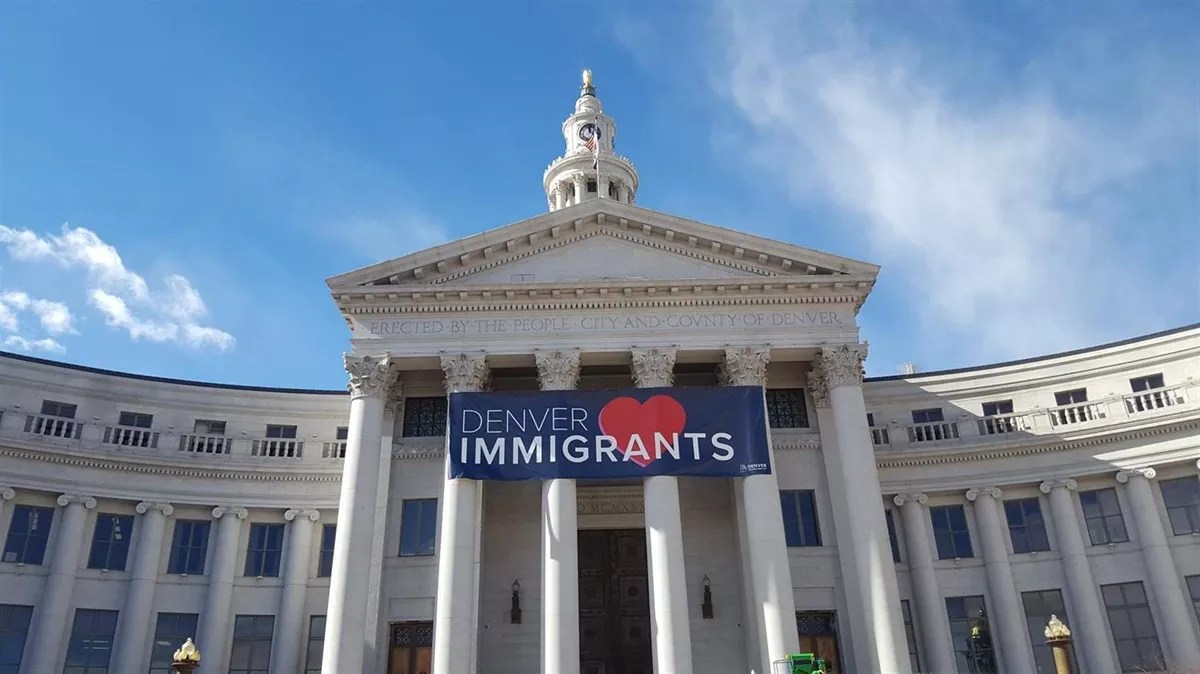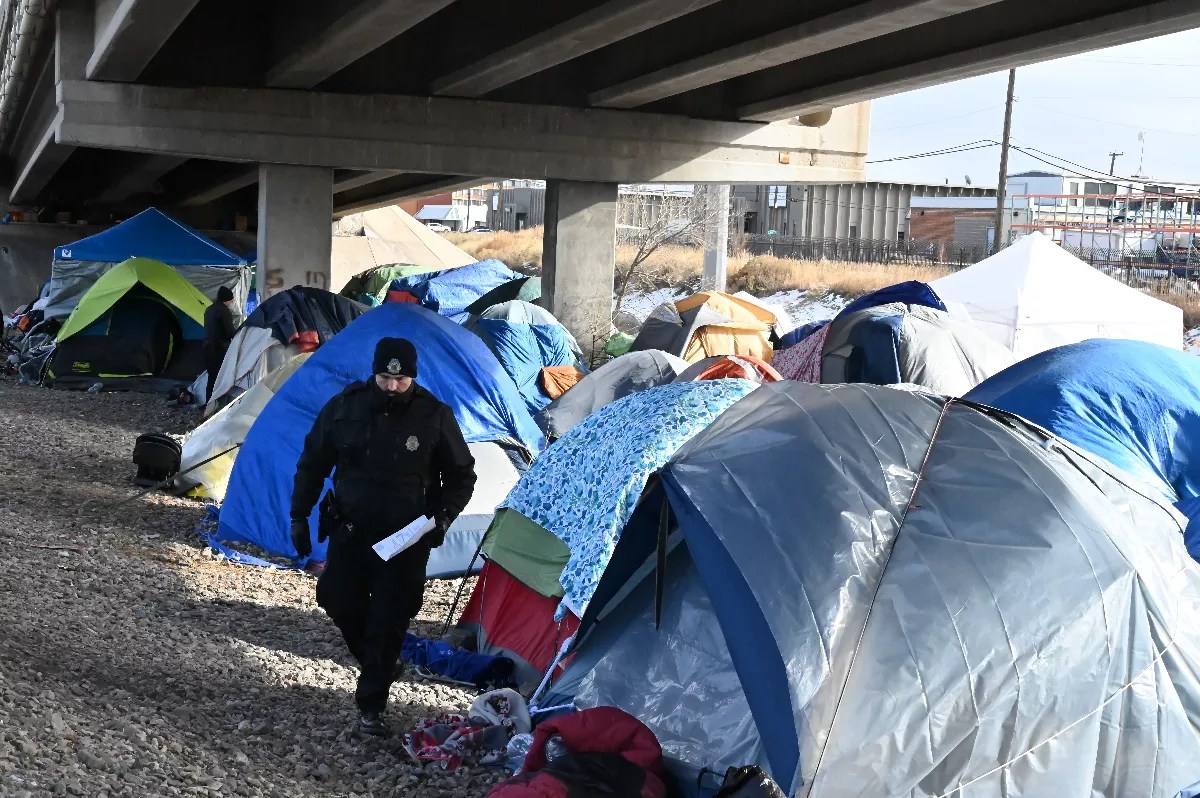
Bennito L. Kelty

Audio By Carbonatix
What is a sanctuary city, and how did Denver become one?
President Donald Trump’s first administration included Denver on a list of “sanctuary jurisdictions” in 2017, but Denver’s federal status as a “sanctuary jurisdiction” is now putting increased pressure on the city’s government, with the White House withholding federal funding and Mayor Mike Johnston called before Congress earlier this year to testify about the city’s immigration policies.
The Trump administration has included Denver on a sanctuary list twice in recent months; the first time was in May, along with nearly 500 other “sanctuary” cities, counties and states. However, that list was withdrawn because it included numerous Republican-leaning communities like Weld and El Paso counties. A revised roster came out on August 5 that listed just Denver and 31 other cities, counties and states, including Colorado. According to the Department of Justice, the new list was “based on actions and policies that materially impede enforcement of federal immigration statutes and regulations.”
On August 15, United States Attorney General Pam Bondi increased the pressure, sending letters to the 32 “sanctuary” jurisdictions that repeated the threat of withholding federal funding and also noted that the administration might seek further legal action for obstructing the work of federal immigration agents.
Denver, make your New Year’s Resolution Count!
We’re $17,500 away from our End-of-Year campaign goal, with just a five days left! We’re ready to deliver — but we need the resources to do it right. If Westword matters to you, please contribute today to help us expand our current events coverage when it’s needed most.
In response to Bondi’s letter, the Denver mayor’s office released a statement saying that “Denver complies with all laws – federal, state and local – and we will continue to defend our rights as well as the rights of our residents.” In a statement to CBS Colorado, Governor Jared Polis’s office said that “Colorado is not a sanctuary state. The Governor continues to be frustrated by this mistaken and incorrect label,” and that Colorado is “cooperating with federal law enforcement.” Days later, Polis sent a letter to Bondi further rebuffing the Trump administration’s demands.
Immigration and Customs Enforcement has been active in Colorado this year, with several ICE arrests and raids challenging Denver’s sanctuary image. Agents, many wearing masks, have arrested hundreds of people in the Denver area, and the majority of people arrested have no criminal records. The agency plans to open new Colorado detention facilities in Ignacio, Hudson and Walsenburg to go along with its facility in Aurora, where about 1,400 immigrants are detained.
Although the term “sanctuary city” is all over the national news now, the term’s ties to Denver stretch back decades. Here’s how we got here, and why the Trump administration is using the “sanctuary” label to go after the city.
What Is a Sanctuary City?
According to Global Refuge, a national nonprofit, the “sanctuary” designation started in 1971, when the local government of Berkeley, California, declared that town a sanctuary for previously deployed U.S. sailors who didn’t want to return to the Vietnam War. However, the term “sanctuary city” is usually traced back to policies passed by U.S. cities in the 1980s to protect Central American refugees.
At the time, El Salvadorans and Guatemalans were fleeing civil wars in their countries, and many were admitted through the U.S. Refugee Act, which set up the modern refugee resettlement process (a process that Trump has largely halted through executive order). Many of the refugees came to the U.S. without permanent legal status, so a religious sanctuary movement sprang up to help them, according to the National Conference of State Legislatures, a Denver-based network.
Other city governments started to join the sanctuary movement. In 1985, Chicago Mayor Harold Washington signed an executive order prohibiting cooperation between local officials and federal immigration authorities. In 1989, San Francisco passed a law banning the use of city funds to help federal immigration law enforcement gather information on people’s immigration status.
Current Denver Water CEO Alan Salazar was the chief of staff under then-Denver Mayor Michael Hancock. He says that Denver has been labeled a sanctuary city “since the Wellington Webb days,” which ran from 1991 to 2003. Back then, Mayor Webb’s administration broadened the term to mean a city that’s “a safe haven for people that are undocumented,” and local leadership used it with pride. But it soon took on “a negative connotation for the city” in some political circles, according to Salazar.
In 2002, former Colorado Congressman Tom Tancredo slapped Denver with the “sanctuary city” label because Webb allowed ID cards from Mexico to be accepted as official identification, Salazar recalls. Although the policy was banned at the state level in 2003, Tancredo and other Colorado Republicans continued hurling the term at Denver, especially after the murder of Denver Detective Donald Young by an undocumented immigrant in 2005.

President Donald Trump has taken aim at sanctuary cities in both of his terms.
Evan Semón Photography
In 2015, 32-year-old Kathryn Steinle was shot and killed in San Francisco by an undocumented immigrant. The charges against the man who killed her were eventually dropped over a lack of evidence, and the term “sanctuary cities” became the target of Republicans entering the presidential race. The next year, in his first presidential campaign, Trump started referring to Steinle’s death as a reason for wanting to go after sanctuary cities.
When Trump took office in January 2017, his administration began defining sanctuary jurisdictions as local governments that refuse to work with ICE. At the same time, Michael Hancock denied that Denver was a sanctuary city because “there was no legal definition,” and the city had never really labeled itself a sanctuary city, Salazar says.
Some cities like Las Vegas and Baltimore have also distanced themselves from the term, while others, like Chicago and Los Angeles, have passed laws declaring themselves sanctuary cities. According to the Federation for American Immigration Reform, a think tank that seeks to reduce immigration, sanctuary cities are a growing trend. It reports that the number of sanctuary cities in the U.S. went from just a dozen in the ’90s to 340 in 2016, 564 in 2018, and more than 1,000 in 2025.
But who’s in charge of deciding which jurisdictions are “sanctuaries,” and which aren’t?
The “sanctuary” designation is blatantly partisan, particularly at the federal level. Every city on the DOJ’s August 5 sanctuary jurisdiction list has a Democratic mayor, and all but one of the states have Democratic governors, with Nevada the lone exception.
Why Is Denver Considered a Sanctuary City?
In 2014, under the Obama administration, ICE started keeping track of cities that turned down detainers, or requests for local law enforcement to hold inmates past their release date to investigate their immigration status. Every year, ICE releases this data and marks some cities as having “policy/legislation that limits or prohibits cooperation with ICE.” In 2015 and 2016, Denver was among the top ten jurisdictions turning down detainers and was reported to have laws against helping ICE.
The Hancock administration insisted that Denver didn’t have policies limiting cooperation with ICE, and justified refusing ICE detainers by citing a 2013 federal court case that defends cities from having to honor detainers.
When Trump took office in 2017, he signed an executive order stating “sanctuary jurisdictions” shouldn’t receive federal funding and said his administration would keep tabs on ICE detainer data to come up with a list of sanctuary jurisdictions. “Sanctuary jurisdictions across the United States willfully violate federal law in an attempt to shield aliens from removal from the United States,” the order read. “These jurisdictions have caused immeasurable harm to the American people and to the very fabric of our republic.”
In August 2017, Denver City Council passed a law banning city employees, including police officers, from asking about a person’s immigration status and from using city resources to assist with federal immigration enforcement. The 2017 law also prohibits honoring ICE detainers, according to the Denver Office of Immigrant and Refugee Affairs

Denver is once again on a short list of sanctuary cities by President Donald Trump.
City and County of Denver
“Denver will send a clear message that every person, no matter their immigration status, can feel safe when interacting with the city and law enforcement,” Hancock said at the time.
A few months later, in January 2018, then-U.S. Attorney General Jeff Sessions threatened to subpoena 23 jurisdictions, including Denver, over their immigration enforcement policies, but the subpoena never arrived. Still, the DOJ denied Denver a $700,000 justice assistance grant to support local law enforcement, prosecution and crime prevention that Sessions had already approved the previous fiscal year.
In August 2018, the 9th Circuit Court of Appeals ruled that Trump’s executive order threatening to keep federal funding from “sanctuary jurisdictions” was unconstitutional. In October, the DOJ handed over the $700,000 grant Denver was expecting.
In May 2019, Colorado lawmakers passed the Protect Colorado Residents From Federal Government Overreach, banning local and state law enforcement from detaining people on behalf of ICE. However, the Trump administration held off on making public threats against Colorado as it had with Denver.
From late 2022 to early 2024, more than 43,000 migrants, mostly from Venezuela, came to Denver. Most of them had crossed the border by securing humanitarian parole, a designation that allows immigrants to enter temporarily for urgent reasons, and were then bused to Denver. Before Trump was re-elected, the Denver mayor’s office estimated that around half of the migrants had stayed in the city. Many Congressional Republicans blamed Colorado and Denver immigration laws for why so many migrants had come to the city in such a short amount of time, while Democrats in Congress pointed to Republican refusal to pass a border protection bill in 2024.
Denver continued to decline ICE detainers, but the state has taken a different direction of late. Despite tougher talk before Trump was re-elected in 2024, Governor Jared Polis came under fire in January for saying the state would cooperate with ICE to deport dangerous criminals. In June, state employees revealed that Polis had ordered them to comply with requests by ICE to give up people’s personal information, but a lawsuit has halted those orders for now.
The Colorado Legislature passed more laws this year that reduce local and state cooperation with ICE. In May, Colorado lawmakers approved a bill that limits where ICE agents can conduct arrests without a warrant signed by a judge; it also prohibits government employees from sharing information about a person’s immigration status with federal law enforcement.
Mayors Johnston and Hancock have preferred calling Denver a “welcoming city” instead of a sanctuary city. Other governments have reacted differently: The City of Lakewood and Arapahoe and Adams counties don’t call themselves sanctuary jurisdictions, but have announced that they won’t enforce immigration law. The City of Aurora declared itself a “non-sanctuary city” in 2017 and again in 2024, while communities like Douglas County and Castle Rock have supported legislation calling on more cooperation with ICE .
How Does Being a Sanctuary City Impact Denver?
According to City of Denver spokesperson Jon Ewing, the impact of being labeled a sanctuary city is “complicated.”
“More broadly, we’ve seen some contracts sent to us with new terminology around immigration and DEI,” Ewing says of the federal government since Trump was re-elected.
The “sanctuary city” designation has had real impacts on Denver, especially its immigrant population. In September 2017, ICE launched Operation Safe City, an immigration roundup initiative in Denver and other cities that the feds considered “sanctuary” jurisdictions, which resulted in nearly 500 arrests.
In March, Republican Congressman Jeff Crank from Colorado Springs tried something similar with a bill to cut federal funding for cities that don’t give ICE two days’ notice before releasing undocumented immigrants from police custody. It was Crank’s first bill, and he used Denver as an example of a sanctuary city that “doesn’t deserve” federal funding.
George Brauchler, the district attorney for Douglas County, blames Denver’s sanctuary city status for crime in his jurisdiction and says he plans to undo Colorado’s sanctuary laws through state legislation and ballot initiatives.

Denver’s decision to provide housing and services to migrants in 2023 and 2024 has resulted in funding rejections and reversals from the Trump administration.
Bennito L. Kelty
When Republicans hauled Mike Johnston to a Congressional oversight hearing in Washington, D.C., in March because of his promise to stand up to ICE, Representative Lauren Boebert called Denver a sanctuary city because of its 2017 law, which she blamed for a rising crime rate. Johnston was there with Democratic mayors from Boston, New York and Chicago, which are also on the newest sanctuary city list.
“It’s shameful, but not surprising, that Denver Mayor Mike Johnston defended his city’s sanctuary city ordinance,” Boebert said in a statement after the testimony. “Our state cannot afford to continue supporting sanctuary city policies; changes must be made and if they won’t happen at the state and local level, I will work directly with the Trump administration to elicit changes from the federal level.”
The Trump administration is following through on threats to cut Denver’s federal funding this year. In April, the Denver Department of Finance announced that the administration had zero plans to pay $24 million that the city had been promised as reimbursement for the migrant crisis in 2022 and 2023.
Under the Biden administration, the Federal Emergency Management Agency promised to reimburse some of the money Denver spent to house and transport thousands of Venezuelan migrants. Denver expected at least $30 million in reimbursements, only for Trump to cut that short because of the city’s “support for illegal aliens,” according to a letter from FEMA.
In April, the Trump administration threatened to withhold upwards of $300 million in transportation funding because of Denver’s immigration policies, but it has yet to follow through. In May, the White House froze millions in grant funding that Denver had received annually to prevent nuclear and terrorist attacks. The DOJ also filed a lawsuit in May against Colorado and Denver for its sanctuary laws limiting cooperation with federal immigration authorities.
Denver has already filed four lawsuits to punch back. It joined two lawsuits with other jurisdictions in May, one to get its FEMA reimbursements and another to secure its previously approved transportation funding. In June, the city filed a lawsuit against the federal government to get its terrorism prevention funding back; it filed another in July, for the Trump administration’s refusal to deliver multiple rounds of federal funding because Denver is considered a sanctuary city.
A federal judge has already ordered a preliminary injunction to free up the federal transportation funding, and the city eventually received its promised terrorism prevention funding after filing its lawsuit. All four cases are still in court, however, and could be overturned, according to Ewing.
The DOJ lawsuit filed in May demands the U.S. District Court in Colorado declare Denver and Colorado’s sanctuary laws invalid; that, too, is still in play.
Despite Polis’s recent willingness to work with ICE, the State of Colorado has also been hit by federal cuts. According to a state dashboard that details funding losses this year, Colorado has already lost $750 million in federal funding under the current Trump administration, mostly annual federal funding that was terminated or not renewed this year.